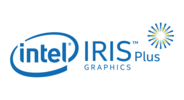Intel UHD Graphics 617 vs Intel Iris Plus Graphics 645 vs Intel UHD Graphics 615
Intel UHD Graphics 617
► remove from comparison
The Intel UHD Graphics 617 (GT2) is a low-end integrated graphics unit, which can be found in the Y-series of the Amber-Lake generation. This "GT2" version offers 24 Execution Units (EUs) clocked at up to 1050 MHz (depending on the CPU model). Due to its lack of dedicated graphics memory or eDRAM cache, the UHD 617 has to access the main memory (2x 64bit DDR3L/LPDDR3). Compared to the old HD Graphics 615 in Kaby-Lake-Y CPUs, the UHD 617 is the same GPU with slightly different clock speeds (depending on the model) and slight power/performance improvements due to the improved 14nm++ process. Compared to the similar UHD Graphics 615 in other Amber Lake models, the 617 looks to be higher clocked (+50 MHz) and has more headroom due to the higher TDP of 7 versus 5 Watt.
Performance
The 3D performance of the UHD 617 depends on the CPU model and the cooling / TDP-setting of the laptop. Furthermore, the used main memory (single channel, DDR3(L), amount) is influencing performance. On average the UHD graphics 617 should be very similar to the Kaby-Lake HD Graphics 615 due to the same architecture and similar speeds. That means that only low demanding games like Farming Simulator 17 or Rocket League are playable in lowest detail settings.
Features
The revised video engine in the HD 615 and UHD 615 / 617 now supports H.265/HEVC Main10 profile in hardware with 10 bit colors. Furthermore, Googles VP9 codec can also be hardware decoded. The UHD 617 should support HDCP 2.2 and therefore Netflix 4K. HDMI 2.0 however is still only supported with an external converter chip (LSPCon).
Power Consumption
The UHD Graphics 617 can be found in Y processors with 7 W TDP and is therefore suited for very thin, mostly passively cooled subnotebooks like the MacBook Air 2018.
Intel Iris Plus Graphics 645
► remove from comparison
The Intel Iris Plus Graphics 645 (GT3e) is a processor graphics card that was first seen in the Apple MacBook Pro 13 (Entry, 2019) in mid 2019. It is similar to the Iris Plus Graphics 655 in the 28 Watt CPUs.
The so called GT3e version of the Coffee-Lake GPU still has 48 Execution Units (EUs), which can reach up to 1150 MHz depending on the model. Besides eDRAM cache, the Iris 645 can also access the system memory (2x 64 Bit DDR3L-2133/DDR4-2400) via processor interface.
Performance
The exact performance of the Iris Plus Graphics 645 depends on the CPU model, because maximum clock as well as the size of the L3 cache can differ a bit. The system memory (DDR3/DDR4) will influence the performance as well.
The fastest chips are high-clocked Core i7 models like the Core i7-8557U. Depending on the game, the Iris Plus 655 will probably be on par with a dedicated GeForce 930M or GeForce 940MX and can handle smooth gameplay in modern titles in low up to medium settings.
Features
The reworked video engine now fully supports hardware decoding of H.265/HEVC videos. Contrary to Skylake, however, Kaby Lake can now also decode H.265/HEVC Main 10 with a 10-bit color depth as well as Google's VP9 codec. The video output is possible via DP 1.2/eDP 1.3 (up to 3840 x 2160 @60 Hz), whereas HDMI is also supported in the older 1.4a standard. An HDMI 2.0 output can be added via converter from DisplayPort. The GPU can drive up to three displays simultaneously.
Power Consumption
The Iris Plus Graphics 645 is used for 15-Watt processor and therefore small-sized notebooks.
Intel UHD Graphics 615
► remove from comparison
The Intel UHD Graphics 615 (GT2) is a low-end integrated graphics unit, which can be found in the Y-series of the Amber-Lake generation. This "GT2" version offers 24 Execution Units (EUs) clocked at up to 1000 MHz (depending on the CPU model). Due to its lack of dedicated graphics memory or eDRAM cache, the UHD 615 has to access the main memory (2x 64bit DDR3L/LPDDR3). Compared to the old HD Graphics 615 in Kaby-Lake-Y CPUs, the UHD 615 is the same GPU with slightly different clock speeds (depending on the model) and slight power/performance improvements due to the improved 14nm++ process .
Performance
The 3D performance of the UHD 615 depends on the CPU model and the cooling / TDP-setting of the laptop. Furthermore, the used main memory (single channel, DDR3(L), amount) is influencing performance. On average the UHD graphics 615 should be very similar to the Kaby-Lake HD Graphics 615 due to the same architecture and similar speeds. That means that only low demanding games like Farming Simulator 17 or Rocket League are playable in lowest detail settings.
Features
The revised video engine in the HD 615 and UHD 615 now supports H.265/HEVC Main10 profile in hardware with 10 bit colors. Furthermore, Googles VP9 codec can also be hardware decoded. The UHD 615 should support HDCP 2.2 and therefore Netflix 4K. HDMI 2.0 however is still only supported with an external converter chip (LSPCon).
Power Consumption
The UHD Graphics 615 can be found in Y processors with 5 W TDP (can be manipulated by the laptop manufacturers, and up 0,5 Watt from the previous generation) and is therefore suited for very thin, mostly passively cooled 2-in-1 notebooks and tablets.
| Intel UHD Graphics 617 | Intel Iris Plus Graphics 645 | Intel UHD Graphics 615 | ||||||||||||||||||||||||||||||||||||||||||||||||||||||||||||||||||||||||||||||||||||||||||||||||||||||||||||||||||||||
| Gen. 9.5 Series |
|
|
| |||||||||||||||||||||||||||||||||||||||||||||||||||||||||||||||||||||||||||||||||||||||||||||||||||||||||||||||||||||
| Codename | Kaby-Lake GT2 | Kaby Lake GT3e | Kaby-Lake GT2 | |||||||||||||||||||||||||||||||||||||||||||||||||||||||||||||||||||||||||||||||||||||||||||||||||||||||||||||||||||||
| Architecture | Gen. 9 Amber Lake | Gen. 9.5 Coffee Lake | Gen. 9 Amber Lake | |||||||||||||||||||||||||||||||||||||||||||||||||||||||||||||||||||||||||||||||||||||||||||||||||||||||||||||||||||||
| Pipelines | 24 - unified | 48 - unified | 24 - unified | |||||||||||||||||||||||||||||||||||||||||||||||||||||||||||||||||||||||||||||||||||||||||||||||||||||||||||||||||||||
| Core Speed | 300 - 1150 (Boost) MHz | 300 - 1150 (Boost) MHz | 300 - 1000 (Boost) MHz | |||||||||||||||||||||||||||||||||||||||||||||||||||||||||||||||||||||||||||||||||||||||||||||||||||||||||||||||||||||
| Memory Bus Width | 64/128 Bit | 64/128 Bit | ||||||||||||||||||||||||||||||||||||||||||||||||||||||||||||||||||||||||||||||||||||||||||||||||||||||||||||||||||||||
| Memory Type | DDR3L/LPDDR3 | DDR3, DDR4 | DDR3L/LPDDR3 | |||||||||||||||||||||||||||||||||||||||||||||||||||||||||||||||||||||||||||||||||||||||||||||||||||||||||||||||||||||
| Shared Memory | yes | yes | yes | |||||||||||||||||||||||||||||||||||||||||||||||||||||||||||||||||||||||||||||||||||||||||||||||||||||||||||||||||||||
| API | DirectX 12_1, OpenGL 4.4 | DirectX 12_1, OpenGL 4.5 | DirectX 12_1, OpenGL 4.4 | |||||||||||||||||||||||||||||||||||||||||||||||||||||||||||||||||||||||||||||||||||||||||||||||||||||||||||||||||||||
| technology | 14 nm | 14 nm | 14 nm | |||||||||||||||||||||||||||||||||||||||||||||||||||||||||||||||||||||||||||||||||||||||||||||||||||||||||||||||||||||
| Features | QuickSync | QuickSync | QuickSync | |||||||||||||||||||||||||||||||||||||||||||||||||||||||||||||||||||||||||||||||||||||||||||||||||||||||||||||||||||||
| Date of Announcement | 30.10.2018 | 10.07.2019 | 30.08.2018 | |||||||||||||||||||||||||||||||||||||||||||||||||||||||||||||||||||||||||||||||||||||||||||||||||||||||||||||||||||||
| Power Consumption | 5 Watt |
|
|
| ||||||||||||||||||||||||||||||||||||||||||||||||||||||||
Benchmarks
3DM Vant. Perf. total + Intel UHD Graphics 615
Cinebench R15 OpenGL 64 Bit + Intel UHD Graphics 617
GFXBench T-Rex HD Offscreen C24Z16 + Intel Iris Plus Graphics 645
Average Benchmarks Intel UHD Graphics 617 → 100% n=8
Average Benchmarks Intel Iris Plus Graphics 645 → 177% n=8
Average Benchmarks Intel UHD Graphics 615 → 84% n=8
* Smaller numbers mean a higher performance
1 This benchmark is not used for the average calculation
Game Benchmarks
The following benchmarks stem from our benchmarks of review laptops. The performance depends on the used graphics memory, clock rate, processor, system settings, drivers, and operating systems. So the results don't have to be representative for all laptops with this GPU. For detailed information on the benchmark results, click on the fps number.

Borderlands 3
2019
Anno 1800
2019
The Division 2
2019
Dirt Rally 2.0
2019
Far Cry New Dawn
2019
Metro Exodus
2019
Apex Legends
2019
Just Cause 4
2018
Darksiders III
2018
Battlefield V
2018
Farming Simulator 19
2018
Forza Horizon 4
2018
Monster Hunter World
2018
X-Plane 11.11
2018
Team Fortress 2
2017
Rocket League
2017
Prey
2017
Civilization 6
2016
Rainbow Six Siege
2015
World of Warships
2015
Dota 2 Reborn
2015
The Witcher 3
2015
GRID: Autosport
2014
Battlefield 4
2013
BioShock Infinite
2013
Tomb Raider
2013
Counter-Strike: GO
2012
Diablo III
2012
StarCraft 2
2010Average Gaming Intel UHD Graphics 617 → 100%
Average Gaming 30-70 fps → 100%
Average Gaming Intel Iris Plus Graphics 645 → 197%
Average Gaming 30-70 fps → 202%
Average Gaming Intel UHD Graphics 615 → 71%
Average Gaming 30-70 fps → 76%
| Intel UHD Graphics 617 | Intel Iris Plus Graphics 645 | Intel UHD Graphics 615 | |||||||||||||||||||
|---|---|---|---|---|---|---|---|---|---|---|---|---|---|---|---|---|---|---|---|---|---|
| low | med. | high | ultra | QHD | 4K | low | med. | high | ultra | QHD | 4K | low | med. | high | ultra | QHD | 4K | ||||
| GRID 2019 | 17.7 | 6.9 | |||||||||||||||||||
| Borderlands 3 | 7.3 | 3.1 | |||||||||||||||||||
| Control | 7.6 | 2.4 | |||||||||||||||||||
| F1 2019 | 12 | ||||||||||||||||||||
| Total War: Three Kingdoms | 15.2 | ||||||||||||||||||||
| Anno 1800 | 12 | 5.22 | |||||||||||||||||||
| The Division 2 | 5 | ||||||||||||||||||||
| Dirt Rally 2.0 | 19.2 | ||||||||||||||||||||
| Far Cry New Dawn | 7 | ||||||||||||||||||||
| Metro Exodus | 6.2 | 3.5 | |||||||||||||||||||
| Apex Legends | 8.8 | ||||||||||||||||||||
| Just Cause 4 | 10.5 | ||||||||||||||||||||
| Darksiders III | 15.7 | 5 | |||||||||||||||||||
| Battlefield V | 5.8 | ||||||||||||||||||||
| Farming Simulator 19 | 42.1 | 15.8 | |||||||||||||||||||
| Hitman 2 | 7.6 | ||||||||||||||||||||
| Assassin´s Creed Odyssey | 7 | ||||||||||||||||||||
| Forza Horizon 4 | 13 | ||||||||||||||||||||
| Shadow of the Tomb Raider | 10 | ||||||||||||||||||||
| F1 2018 | 19 | 12 | |||||||||||||||||||
| Monster Hunter World | 11.5 | ||||||||||||||||||||
| Far Cry 5 | 6 | ||||||||||||||||||||
| World of Tanks enCore | 95.1 | 11.8 | |||||||||||||||||||
| X-Plane 11.11 | 20.2 | 14.1 | 12.8 | 37.4 | 26.1 | 22.5 | 11 | 8 | 8 | ||||||||||||
| Final Fantasy XV Benchmark | 6.1 | 3.3 | |||||||||||||||||||
| Fortnite | 15.9 | 8 | |||||||||||||||||||
| ELEX | 9.2 | ||||||||||||||||||||
| Middle-earth: Shadow of War | 16 | 7 | |||||||||||||||||||
| Team Fortress 2 | 51.8 | 45.6 | 29 | ||||||||||||||||||
| Rocket League | 61.2 | 26 | 18.3 | 41 | 16 | 10.3 | |||||||||||||||
| Prey | 15 | 8 | |||||||||||||||||||
| Ghost Recon Wildlands | 8.1 | ||||||||||||||||||||
| For Honor | 16.4 | ||||||||||||||||||||
| Civilization 6 | 29.5 | ||||||||||||||||||||
| Overwatch | 29.9 | 21.6 | |||||||||||||||||||
| Rise of the Tomb Raider | 16.1 | 12 | 8 | 5.3 | |||||||||||||||||
| Rainbow Six Siege | 31.3 | 19.5 | |||||||||||||||||||
| World of Warships | 53 | 34.6 | |||||||||||||||||||
| Dota 2 Reborn | 67.2 | 28.2 | 14.6 | 13.6 | 76.5 | 57.3 | 29 | 26.9 | 53 | 25 | 13 | 11 | |||||||||
| The Witcher 3 | 10 | 5.9 | |||||||||||||||||||
| GTA V | 16.4 | 16.9 | |||||||||||||||||||
| Middle-earth: Shadow of Mordor | 27.8 | 16.7 | |||||||||||||||||||
| GRID: Autosport | 97.4 | 34.4 | 24.7 | ||||||||||||||||||
| Battlefield 4 | 28 | 20 | 14 | ||||||||||||||||||
| BioShock Infinite | 47.6 | 27.9 | 25 | 8.4 | 104.6 | 60 | 51.6 | 22.1 | 39 | 22 | 18 | 5 | |||||||||
| Tomb Raider | 56 | 29 | 19 | 7.9 | |||||||||||||||||
| Counter-Strike: GO | 100.2 | 61.4 | 36 | ||||||||||||||||||
| Diablo III | 54.7 | 37.5 | 33.9 | 19.4 | |||||||||||||||||
| The Elder Scrolls V: Skyrim | 41.7 | 23.3 | |||||||||||||||||||
| Deus Ex Human Revolution | 58 | 39.6 | 16 | ||||||||||||||||||
| StarCraft 2 | 144.1 | 36.3 | 23.5 | ||||||||||||||||||
| Intel UHD Graphics 617 | Intel Iris Plus Graphics 645 | Intel UHD Graphics 615 | |||||||||||||||||||
| low | med. | high | ultra | QHD | 4K | low | med. | high | ultra | QHD | 4K | low | med. | high | ultra | QHD | 4K | < 30 fps < 60 fps < 120 fps ≥ 120 fps | 2 1 2 | 4 | 4 | 2 | | | < 30 fps < 60 fps < 120 fps ≥ 120 fps | 1 2 | 1 1 1 | 2 1 | 2 | | | < 30 fps < 60 fps < 120 fps ≥ 120 fps | 36 11 3 1 | 26 5 1 | 10 3 | 5 | | |
For more games that might be playable and a list of all games and graphics cards visit our Gaming List

































